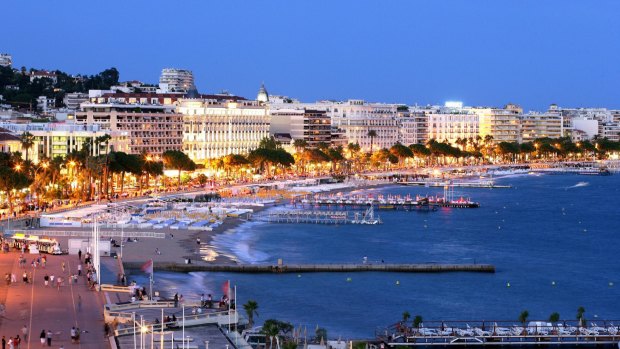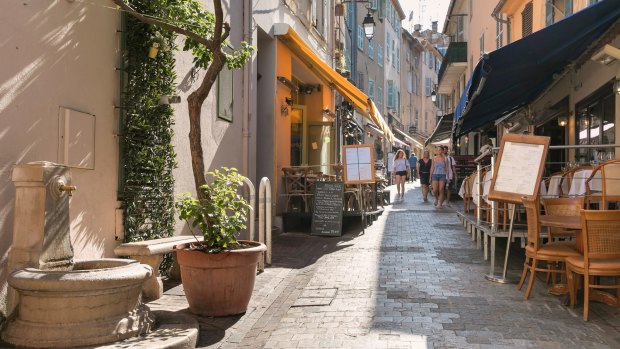This was published 1 year ago
Cannes travel guide: Things to do in the city beyond its famous film festival

La Croisette, Cannes' curving two-kilometre promenade.Credit: Cannes Tourism
We've all seen clips of Cannes during its annual May festival, when the world's top film-makers - actors, directors, producers - hit the palm tree-lined seafront, drawing crowds, critics and camera flashes from the paparazzi. But for the other 350 or so days of the year, this sun-kissed French Riviera resort is still worthy of rave reviews (with the added bonus of mercifully less traffic and clamour than at festival-time).
Cinephiles will always be in their element here. There are the so-called Walls of Cannes to scout out, in which silver-screen icons, such as Buster Keaton, Charlie Chaplin and Alain Delon are immortalised in giant murals across the city (my favourite is one of Marilyn Monroe, who adorns the side of the Cannes Riviera Hotel on Boulevard d'Alsace). Eyes are also drawn to Cannes' answer to Hollywood's Walk of Fame. Handprints of 150 celebrities - including Angelina Jolie, Quentin Tarantino and Johnny Hallyday - engrave the pavements by the modernist convention centre, a festival hub that also contains the city's tourist office (call in for maps and tips). Outside, you can mimic the posing festival stars by scaling the building's 24 red carpet-covered steps (you might have to queue for your selfie).
There's no denying Cannes' glitzy and glamorous side. In the Vieux-Port, gleaming superyachts overshadow painted little fishing boats, while realtors windows' advertise multi-million euro vessels and villas. Strolling along La Croisette, the curving two-kilometre promenade, you'll pass perfumed luxury stores and Art Deco-inspired hotels, like the Martinez and Le Majestic, whose guests are pampered at private beach clubs that are separated from the publicly-accessible strips of golden sand.

Cannes' old town, Le Suquet, has, in parts, a classic Provencal aura.Credit: Cannes Tourism
Yet Cannes has an earthier, grittier face - one that predates its emergence, in the mid-19th century, as a fashionable holiday magnet. The old town, Le Suquet, has, in parts, a classic Provencal aura. Evergreen trees and plants blossom by sloping, pedestrianised cobblestone lanes and stairways that wriggle past pastel houses and apartments. By the hilltop stone Notre-Dame church, panoramic terraces overlook a city splendidly located between verdant mountains and Mediterranean Sea. While slices of the old town ooze peace and quiet, others, like Rue du Suquet, buzz with wine bars and bistros, offering terrace seating and "prix-fixe" menus that won't break the bank (think: three courses for $40).
Alternatively, shop for ingredients at Marche Forville, a lively, aromatic covered morning market (open daily except Monday). Vendors sell flowers, soaps and the tastebud-soothing pleasures of Provence: organic fruits, vegetables, fish, herbs, jams, spices, olives, cheeses, charcuterie. We grab some goodies to complement our sandwich-baguettes from the nearby, award-winning Boulangerie Fred, then we head to the port, where ferries zip out to the pine-cloaked, car-free Lerin Islands anchored in the Bay of Cannes.
Tempted by the petite Ile Saint-Honorat, where a Cistercian monastery has housed monks since the fifth century, we opt instead for the larger (but still petite) Ile Sainte-Marguerite, just three kilometres long and almost one kilometre wide, and home to a handful of permanent residents itself. Alighting after the 15-minute crossing from Cannes (€16 return or $25 for adults), we follow fellow passengers up to Fort Royal, a 17th-century prison fort, built on the cliffs, over ancient Roman fortifications. Now a museum, displaying objects from shipwrecks, Roman cisterns and frescoes, plus contemporary art, the fort showcases the cell that held captive a mysterious unknown prisoner in the reign of Louis XIV. Nicknamed "The Man in the Iron Mask", he was later popularised in Alexandre Dumas' 1850 novel.
Leaving the fort behind, we skirt by its chunky, vegetation-shrouded walls and descend steps back to the waterfront, where staff at an upscale restaurant (La Guerite) are receiving a pre-lunch pep talk. Loungers are spread out next door, priced at €150-200 a pop. The crowds thin out as we tread the footpaths encircling and criss-crossing the island, the warm August breeze assailing our nostrils with salt, pine and eucalyptus scents. Regular gaps in the trees afford glimpses of Cannes and Ile Saint-Honorat and we watch kayakers and paddleboarders float past rugged coves caressed by turquoise-inked waters.
Some of the island's coastline is cluttered with yachts, bathers and snorkellers - particularly near the new Underwater Eco-Museum, where submerged human face sculptures by British artist Jason deCaires Taylor grace the seabed. Thankfully, there are empty and serene coves, too, including the ever-so-pretty, blissfully shaded spot where we break for our picnic.
THE DETAILS
FLY
Emirates fly to Nice from Sydney and Melbourne via Dubai. Cannes is a 45-minute transfer by airport bus or taxi.
MORE
Sign up for the Traveller Deals newsletter
Get exclusive travel deals delivered straight to your inbox. Sign up now.